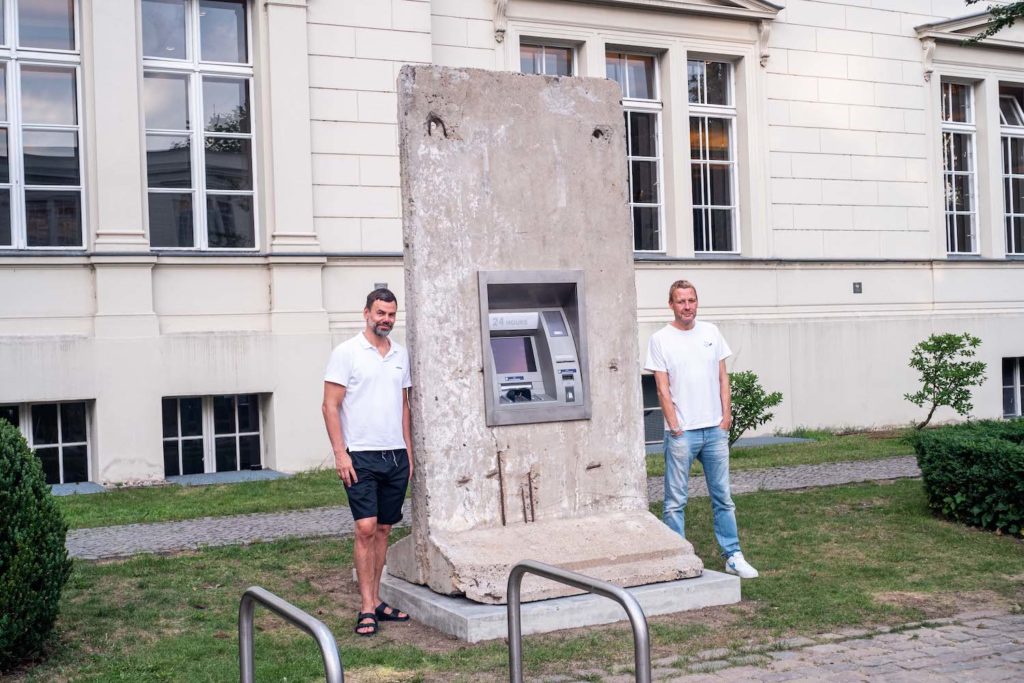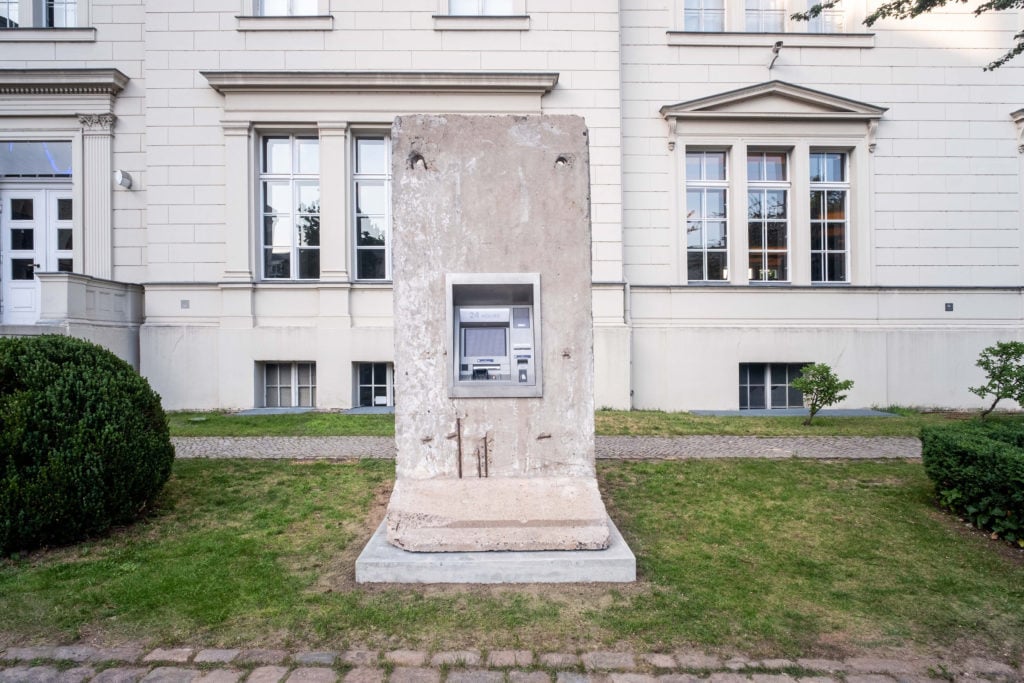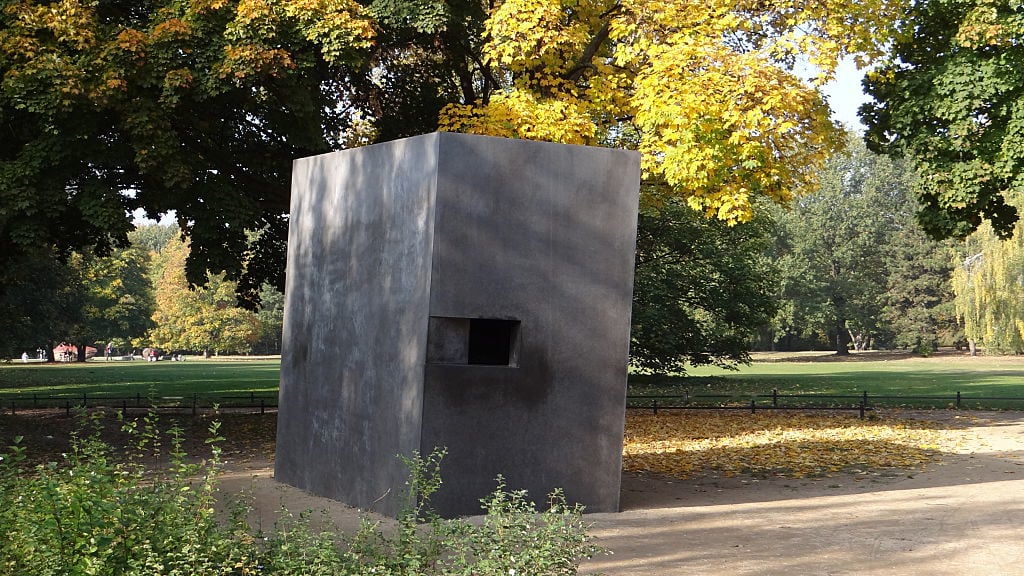On View
Artist Duo Elmgreen and Dragset on Why They Installed a 24-Hour ATM Into a Section of the Berlin Wall
The fake cash machine is now on permanent display outside the Hamburger Bahnhof.

The fake cash machine is now on permanent display outside the Hamburger Bahnhof.

Kate Brown

In the late years of Cold War-era Berlin, East Germans were given “welcome money” whenever they crossed over to the West. And then, in 1989, when stepping over the rubble of the Berlin Wall, former East German citizens were able briefly to exchange their communist currency at a 1:1 ratio for the stronger West German deutsche mark. The politics of the wall during separation, and also post-unification, had multiple dimensions—but freedom, in no small part, was transactional.
Berlin’s newest public sculpture, which will be unveiled today by the artists Elmgreen & Dragset at the Hamburger Bahnhof, is an ironic reminder of the financial symbolism entrenched in the city’s history, as well as the hopes and disappointments that followed Germany’s reunification. It is also a monument against nostalgia for life in the former German Democratic Republic, often referred to as “Ostalgie.”
The Berlin-based duo managed to acquire a small piece of the concrete barrier, into which they have installed an ATM. The work, called Statue of Liberty, goes on permanent display in the museum’s courtyard, a former train station that is now one of Germany’s preeminent museums. The fact that Elmgreen & Dragset’s sculpture stands within walking distance of the former border will not be lost on locals, though it might confuse a few tourists seeking to take out some cash.
“Most people from the German Democratic Republic had high hopes for a better standard of living after unification, but instead many were just left with no job and no dignity,” Michael Elmgreen and Ingar Dragset told artnet News ahead of the unveiling. “In Berlin, several landmarks from that time period were also erased, as if that chapter in history had never happened,” they added. The Hamburger Bahnhof languished in the no-man’s land between the border for decades before it was officially absorbed into West Berlin.
Statue of Liberty was acquired by the prominent German collector Heiner Wemhöner from König Galerie at Art Basel last year. Wemhöner has now donated it to the art museum named after the former station—the artists are delighted that the work will be able to stay on public view in the German capital.

Elmgreen & Dragset, Statue of Liberty, (2018) Copyright the artists, courtesy of the Staatliche Museen zu Berlin, Nationalgalerie, 2019 Donation by Heiner Wemhöner, Herford to the Foundation of the Verein der Freunde der Nationalgalerie / Mathias Völzke.
In general, they’re skeptical about the oversimplification of the era when East and West Germany were divided. “We find it a bit arrogant to speak about nostalgia for East Germany, the so-called ‘Ostalgie,'” they say. “Speaking about that relates to a lot of people’s upbringing, their past and their pride, the entire value system that generations had been taught.”
In a local sense, the new piece seems especially timely as the government debates a rent freeze for five years to combat the skyrocketing cost of living in Berlin. The Scandinavian duo, who have been living in the capital since the late 1990s, can remember the city after the Berlin Wall fell. “It was a beautiful mess, and no one had a clue about how the different neighborhoods would develop, which areas would become posh and pricey, and which areas would avoid the worst of gentrification.”
They also remember the art scene of the time, and how it was not dominated by commercial concerns. “Due to a non-existent art market, but a lot of energy and very low rents, you would experience an atmosphere where dinner conversations between gallerists, curators, and artists were never about real estate or the prices of artworks.” It was also a time of “demographic turbulence, in which many citizens of the former GDR moved out of their old neighborhoods and new people moved in, not necessarily because of increased rents but more because of the new possibilities to relocate.”
It took some time to find a piece of the Berlin Wall without any graffiti for their work. Most of the postcard-worthy stretches of the wall, those that look more like the touristic East Side Gallery, are splashed with vibrant and Instagram-ready murals. But they point out that most of those were added after 1989. It is an example of what the artists call the “falsification of history” about the former East Germany.
Statue of Liberty is not their first public monument in Berlin that addresses the city’s complex history. Their 2008 Memorial to the Homosexuals Persecuted under the National Socialist Regime is tucked just behind a group of trees in Tiergarten park. It is a searing and emotional tribute to the suffering of LGTBQ people in the Nazi era. Through a small window in a slanted concrete block, one can see a video of two men kissing on loop.

Memorial to Homosexuals Persecuted Under Nazism. Photo by Popow/ullstein bild via Getty Images.
Meanwhile, the door of a famed 1990s techno nightclub, Tresor, was installed this week inside the Humboldt Forum, a controversial new museum under construction that stands on the old site of a GDR landmark, the Palast der Republik. The former East German parliament was pulled down in 2006 to make way for a replica of a former Prussian palace, the Berlin Schloss—it was a move that deeply divided opinions.
But, unlike the relic from Tresor, as an artwork, Statue of Liberty is profoundly ironic. It rather speaks to the mechanisms that saw East Berlin’s cultural heritage become neutralized by money, nostalgia, and fetishization.
“For a long time, this approach has been a ticking bomb and it has now unfortunately resulted in the rise of right-wing populism,” they say. “The title Statue of Liberty might beg the question: What kind of freedom have we obtained? Economically, some seem radically freer than others. But the title also speaks about how our idea of freedom is threatened not only locally, but also globally, in our current time.”